Constructing a More Sustainable Future for the UK Economy

Image from FreePik
 This article is based on a report by the Green Alliance UK By Libby Peake, Heather Plumpton and Jasmine Dhaliwal.
This article is based on a report by the Green Alliance UK By Libby Peake, Heather Plumpton and Jasmine Dhaliwal.
In the UK, the building industry is the largest user of raw materials, generates the most waste, and accounts for 25% of all carbon emissions. It has to be revamped.
Apart from the effects on the environment, it also has to deal with issues like the scarcity of housing, the affordability crisis, risks in the supply chain, and the requirement to make sure infrastructure and buildings are ready for a net zero carbon future.
Change is on the way. Starting in 2025, new construction must produce 75–80% less carbon dioxide after construction due to energy efficiency regulations.
However, this won’t help with every issue the industry faces or all of the environmental effects the sector is accountable for.
An obvious solution is a more circular economy, as many are starting to realize. This means that less raw material will be used during construction as long as design modifications are made and materials and buildings as a whole are preserved for as long as possible. It refers to the regeneration, reuse, and recycling of construction materials that have already reached the end of their initial life.
Without the existing detrimental effects, a circular construction sector would contribute to building the infrastructure and housing the nation needs. Numerous circular measures also present chances to lower housing costs, boost productivity, ease supply chain pressures, enhance supply chain efficiency, and boost corporate profitability. Circular construction business models have been demonstrated in prior study to boost profitability and improve financial returns by up to 26%.
The report’s study done by the Green Alliance suggests that existing techniques and technologies might reduce raw material utilization by more than a third by 2035. This might relieve pressure on land use, biodiversity, water, and waste management while also reducing the sector’s carbon impact by 39%.
In order to initiate this shift, the government should take the lead and establish an ambitious, industry-specific resource reduction objective for building. It should then assist the industry in achieving it by giving three areas top priority for immediate attention.
Support and financial incentives
The government should immediately address the disparity in VAT rates between newly constructed buildings, which are currently zero-rated, and retrofitting, which is subject to a 20% rate. The VAT holiday for energy-saving goods, such as heat pumps and insulation, ought to be extended to additional retrofitting projects that maintain or enhance a building’s environmental efficiency and made permanent. A finance package ought to assist start-ups that are small and creative in developing new products for the market, enhancing the recycling of building materials, and creating backup supply networks.
More retrofitting and circular design
The central government has to take a cue from London and mandate the submission of a circularity declaration for any development beyond a specific scale. As circular design becomes more common, this needs to be expanded.
Before obtaining planning permission to replace existing structures, pre-demolition evaluations must to be carried out in order to provide a strong case for demolition in terms of material consumption and carbon emissions.
More accurate data
Until there are established and widely accepted measures for circularity, progress will be restricted. The UK Green Building Council, the Institute for Structural Engineers, and other organizations should be encouraged to develop the appropriate measures and then have their use mandated by the government through coordination and assistance. Additionally, it ought to facilitate and coordinate the creation of “material passports” for structures, which would track vital details regarding the materials, components and products used in them.
One industry with enormous unrealized potential to enhance performance is construction, where there are still many low hanging fruit opportunities to reduce resource use and mitigate the effects of climate change. To guarantee that the industry is prepared for the future, the government should take action right away.
2050 Materials plays a big role in making data accessible to designers, architects and developers by providing over 100,000 products populated with sustainability data from EPDs and other certifications.
By using 2050 Materials platform, you can find beautiful and sustainable building materials, compare their carbon emissions and measure the impact of your full project through the LCA tool created.

Making infrastructure sustainable
In order to establish a green economy in the UK, a new strategy for resource usage and a reduction goal are required. This will lessen the effects of climate change while simultaneously halting and even reversing environmental degradation.
According to United Nations’ estimates, half of the world’s carbon emissions, 90% of biodiversity loss, and 90% of water stress are caused by the extraction and processing of resources, food, and fuel. As we’ve demonstrated before, the UK government need to strive for a complete cutback in the amount of resources used.
Devolved administrations have already taken the lead, setting goals to align it with planetary bounds.
Given that the UK uses about 15 tonnes of non-renewable resources annually per person, compared to the UN’s estimated sustainable level of six to eight tonnes, it is recommended that England and Northern Ireland set a goal to half their raw material use by 2050.
This is especially crucial for the building industry, which accounts for 25% of the nation’s consumption emissions, produces the most trash, and utilizes the greatest amount of materials in the UK. The government should make it a top priority to establish precise, long-term goals for reform.
The government of England is empowered to set such targets under the 2021 Environment Act. Unfortunately, the government decided to only create a legally binding aim for waste minimization in December 2022, abandoning early intentions for a target to boost economy-wide resource efficiency. This leaves out the main mineral wastes from building, which account for the majority of the UK’s waste stream and are “the most resource intensive industry in the UK has huge scope to reduce its use of materials.”
It is have shown that the most resource-intensive industry in the UK has enormous potential to cut its material use, mostly through the application of best practices and existing technologies.
The study done by the Green Alliance is based on an examination that researchers at the UK FIRES academic collaboration are about to publish. This analysis has given us a thorough baseline of material use in the UK construction industry. To determine how quantifiable resource efficiency and demand reduction strategies might influence the material needs for upcoming structures and infrastructure, we examined their possible effects.
Two workshops with academics and industry officials are conducted to test the findings, and sixteen different corporations and trade associations were spoken to.
This has made it possible to pinpoint the obstacles preventing the construction sector from using its resources more effectively and the quick fixes required to get beyond them and the industry has made it quite evident that substantial material savings in the UK building sector are achievable with the appropriate rules, incentives, and measurements.
The environment and the construction industry
In the UK, one of the largest and most significant industries is building. Every citizen’s life is shaped by the buildings in which we live, work, learn, and shop, as well as the infrastructure that dictates how we get around.
Nonetheless, the industry must adapt. Its issues include low productivity, hazards associated with the supply chain, the housing and affordability crises, and the need to retrain its aging workforce. Additionally, the industry is in charge of making sure that infrastructure, both new and old, is ready for a net zero future.
 It is the industry's responsibility to guarantee that infrastructure, both new and old, is suitable for a net zero future.
It is the industry's responsibility to guarantee that infrastructure, both new and old, is suitable for a net zero future.
There will soon be changes in certain locations as the Future Homes and Buildings Standard introduces new energy efficiency criteria.
As of 2025, newly constructed buildings must produce 75 to 80% less carbon dioxide after construction, a requirement that some observers have called for “fundamentally changing the way that we design and build homes in the UK.”
However, not all of the sector’s environmental effects will be addressed by the emphasis on energy efficiency. Construction-related emissions are mostly caused by the materials used in the process.
By 2035, embodied carbon is predicted to make up half of the emissions from the built environment as mentioned in the UKGBC roadmap. When supply networks located abroad are taken into account, the total amount of CO2 emissions in 2018 was around 43 million tons. Of them, the extraction, processing, and manufacturing of resources accounted for 60%. More than 150 organizations in the building industry are supporting the Part Z project, which is a campaign by the sector to push for future building standards that take whole life carbon emissions into consideration.
Based on studies, it is recommended that building standards should go beyond merely addressing material consumption. The sector consumes enormous amounts of resources both domestically and internationally, including more than 500,000 tonnes of minerals per day. Additionally, it is in charge of producing the majority of garbage; in 2018, construction, demolition, and excavation accounted for 62% of waste created in the UK.
The issue with concentrating solely on operational carbon and waste is that it fails to address the primary concern of the sector, which is the excessive use of resources. Ecosystem degradation and other major environmental effects are being caused by the mining of raw materials.
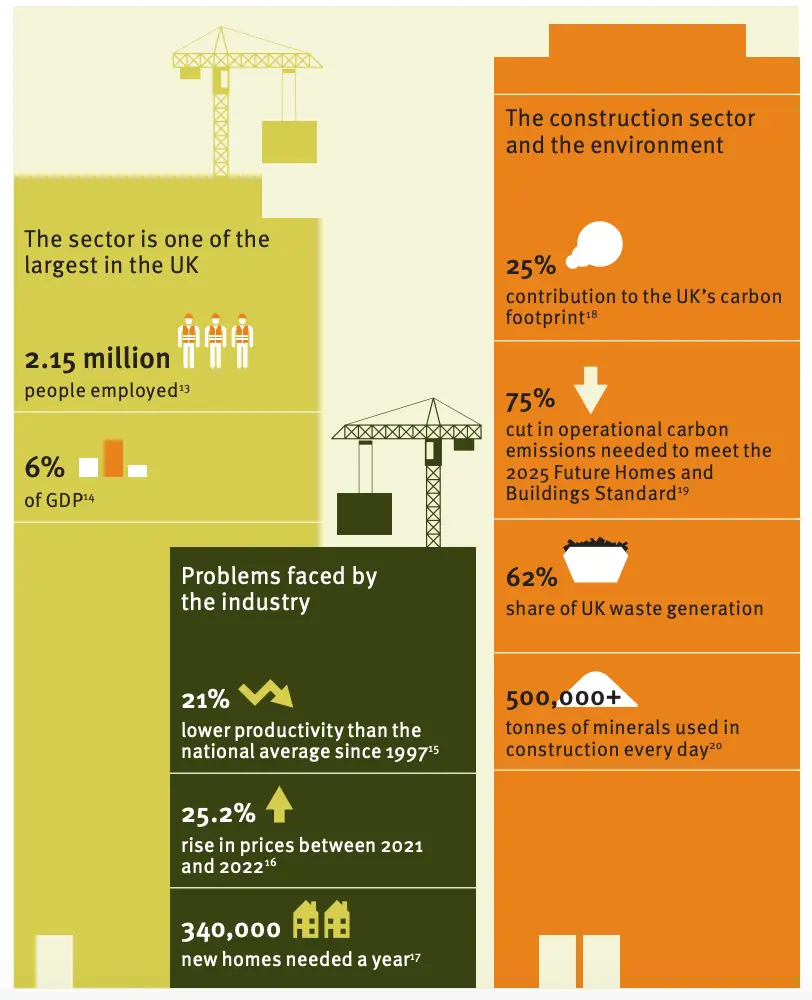
Snapshot of the UK construction sector at a glance by the Green Alliance
Carbon in Construction
Embodied Carbon:
- Greenhouse gases from extracting and processing materials, manufacturing products, and constructing buildings.
- Includes emissions from transportation and construction site activities.
- Additional embodied emissions come from materials and parts used in maintenance throughout a building’s lifetime.
Upfront Carbon:
- A subset of embodied carbon, representing emissions released before construction is completed.
- Excludes embodied emissions from maintenance and repairs.
- For most buildings, upfront carbon is a larger portion than maintenance or operational emissions.
- Accounts for over half of a domestic building’s total emissions.
Operational Carbon:
- Emissions from daily energy consumption of a building.
- Targeted by government regulations like Part L of the Building Regulations and the Future Homes and Buildings Standard.
- Only includes emissions related to fixed building systems (heating, cooling, ventilation, water, lighting).
- Emissions from IT equipment, cooking, refrigeration, and external lighting are not regulated.
Whole Life Carbon:
- Total emissions over a building’s entire lifespan, including upfront embodied carbon, maintenance-related embodied emissions, and operational carbon.
- Combines regulated and unregulated operational emissions.
- The accuracy of whole life carbon assessments depends on the estimated lifespan of the building, which can be challenging to determine.
The solution to many of the environmental and other problems facing the construction sector is adopting a more circular economy, as many now realize. This involves reducing raw material use through design changes and focusing on preserving materials and entire buildings at their highest value for as long as possible. It means regenerating, reusing, and recycling materials at the end of their first life. This approach would provide the housing and infrastructure the country needs while minimizing environmental impacts and potentially leading to more affordable housing and higher productivity. Financially, circular construction is beneficial for companies: research by Arup and the Ellen MacArthur Foundation into five circular construction business models found they all increased profitability, with one improving financial returns by as much as 26%. Retrofitting can offer cost savings over demolition and new build, as demonstrated by the Triton Square retrofit for British Land’s headquarters in London, which took 30% less time and cost 15 to 18.5% less than new construction. Innovation in circular construction is in its early stages. In the UK, London has led the push for change by requiring circular economy statements and whole life carbon assessments for the largest developments referred to the mayor’s office, resulting in new circular product suppliers struggling to meet demand. Many see this as an important development that, if widely adopted alongside other regulatory drivers and financial incentives, could drive action and a different mindset across the industry.
Insight from Experts
Green Alliance consulted widely with experts in industry, trade associations, and academia. They highlighted that there are currently few incentives to adopt circular practices in UK construction. Progress is hindered by design and demolition practices, disjointed supply chains, and low material prices, particularly for cement and concrete. These factors lead to excessive material use, unnecessary demolition, and material-intensive new builds, which are perversely more economically viable than renovation. It need not be this way. The experts agreed that technologies to improve material use and the environmental performance of the construction industry already exist. Many suggested that regulation is the best way to ensure these technologies are deployed. One industry representative called policy the “most potent” way of driving change in the sector, while another insider noted that regulation has historically been one of the “principal drivers of innovation.”
 "Excess material use is rife, and unnecessary demolition and material intensive new build are the norm."
"Excess material use is rife, and unnecessary demolition and material intensive new build are the norm."
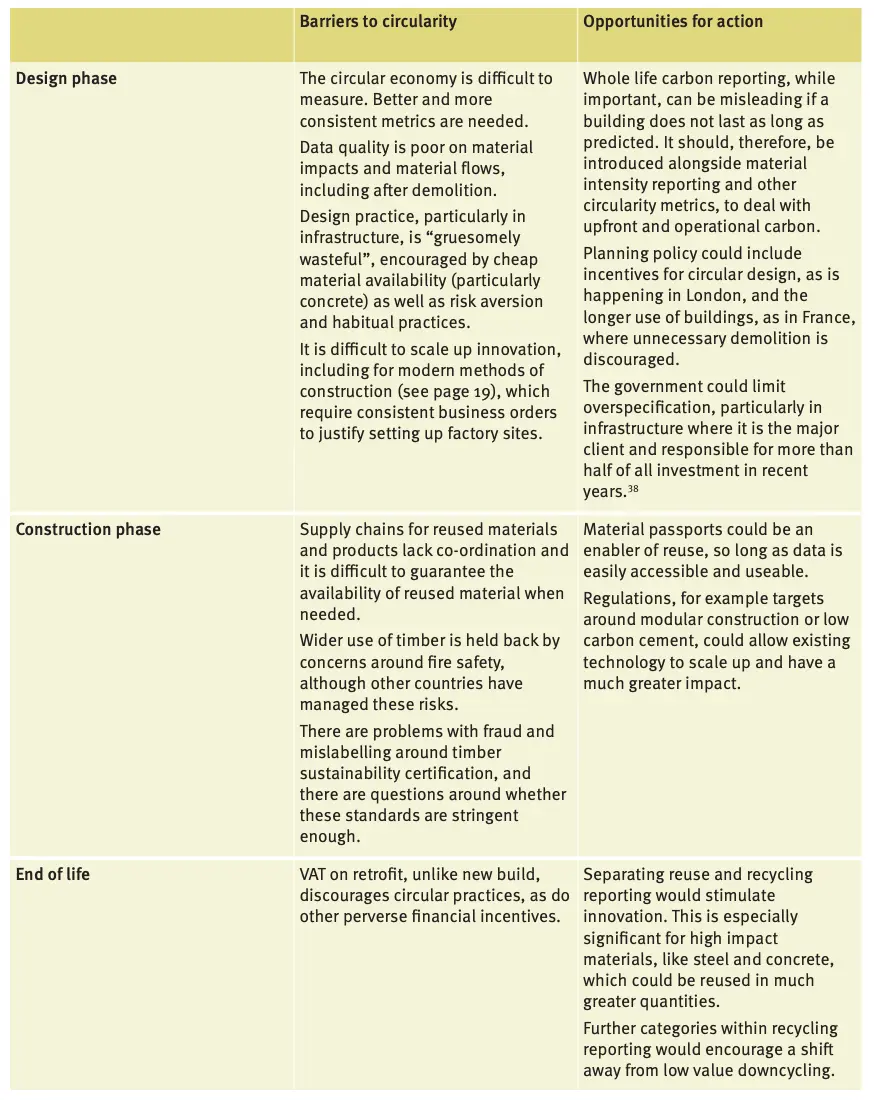
Table from Circular Construction by the Green Alliance report
The path towards a circular economy
The amount of raw material needed for constructing housing, offices, shops, schools, and infrastructure can be significantly reduced by transitioning to a circular construction sector. This approach has two main features: reducing the amount of virgin resources newly extracted or manufactured per building, and ensuring materials remain in use at their highest value for as long as possible by prioritizing renovation over new builds. The first goal can be achieved through better design, reusing components and materials, and increasing recycled content. The second goal involves extending the lifetimes of existing buildings, components, and materials by adapting them for new uses, such as converting office blocks into flats. This also helps increase housing density in urban centers, promoting lower carbon lifestyles.
Material use in construction
Today’s construction sector uses nearly 100 million tonnes of materials annually for new buildings and infrastructure projects. This figure excludes materials for internal fittings, such as bathrooms, kitchens, lighting, and furniture, which are often replaced multiple times during a building’s lifetime. Nearly two-thirds (61%) of these materials are used in buildings, including houses, flats, offices, and public buildings, while the remaining 39% are used in infrastructure and other construction projects for transport, power, communications, water, and waste. Reuse and recycling of steel, glass, aluminum, timber, and aggregate in concrete meet 18 million tonnes of the sector’s demand. Concrete is the dominant primary raw material, comprising 79% of all new material, and an even higher proportion in infrastructure projects.
Potential changes to construction by 2035
Material use in construction is immense and primarily dominated by concrete, but this could change with circular practices. These practices could reduce material use and its associated environmental impacts. To illustrate their potential impact, we compared a business-as-usual scenario, where construction practices continue as they are and material use remains similar to today, with a 2035 scenario where a more circular industry prioritizes resource efficiency and reduces demand for new buildings and infrastructure.
For the 2035 circular scenario, we modeled interventions that lead to significant material reduction, based on academic research, to demonstrate their potential cumulative impact. As we focused on available technologies and best practices, it is likely we have underestimated their long-term potential, and other measures and changes will be possible in the future. Increased support for innovation is also likely to lead to further resource savings.
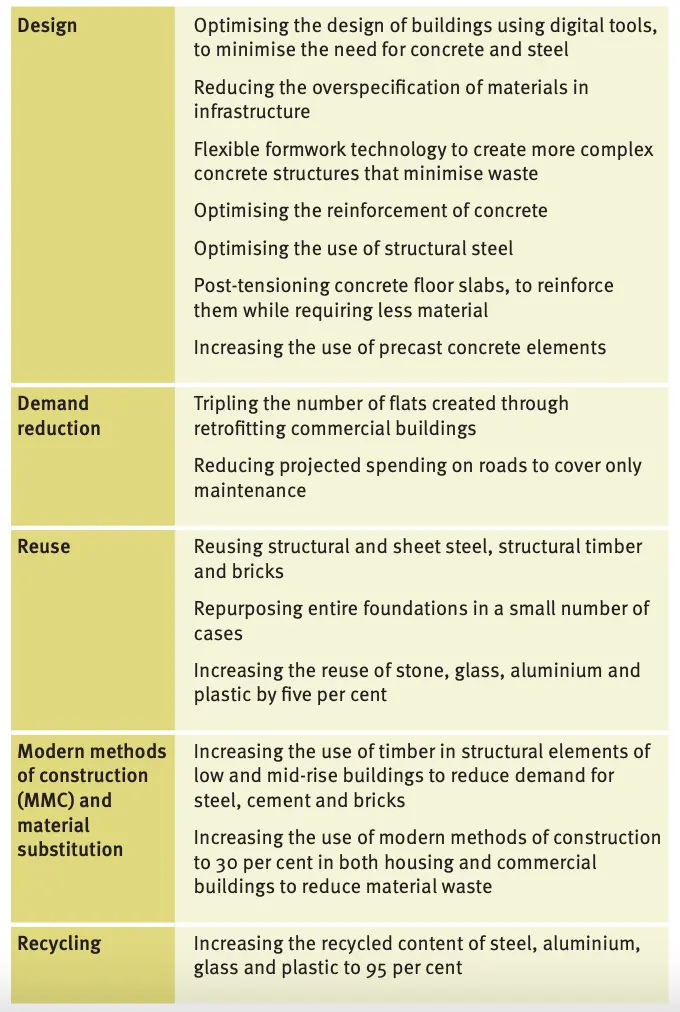
Circular measures modelled by the Green Alliance
Modern methods of construction (MMC) involve onsite technologies and offsite manufacturing of building components, offering alternatives to traditional construction. MMC includes using drones, factory-made building components, and entire housing modules made remotely and transported to the site. Offsite manufacturing can improve resource efficiency, reduce waste by up to 90%, lower embodied carbon by 45%, and enhance productivity with fewer onsite labor needs and faster project completion. If scaled up, MMC could reduce costs by 20–40%.
The government supports MMC through a taskforce and the Affordable Homes Programme, which mandates 25% of new housing be delivered this way. However, barriers include financing risks, planning uncertainties, and insufficient recognition of MMC’s environmental benefits in public procurement. Experts also highlight challenges in recycling modular homes and potential negative impacts on employment due to reduced onsite labor. Design considerations for disassembly and reuse, as well as planning for a just transition, will be important as MMC becomes more prevalent.
By 2035, circular initiatives might reduce the usage of raw materials by more than a third.
Compared to doing business as usual, our circular scenario reduces the amount of raw materials needed in construction by 35% by 2035. Circular measures have the potential to stop the extraction of 418 million tons of raw material between now and 2035 — an amount equal to the total required to construct 1.7 million detached homes.
 "Interventions optimising material use at the design stage have the most impact." The Green Alliance
"Interventions optimising material use at the design stage have the most impact." The Green Alliance
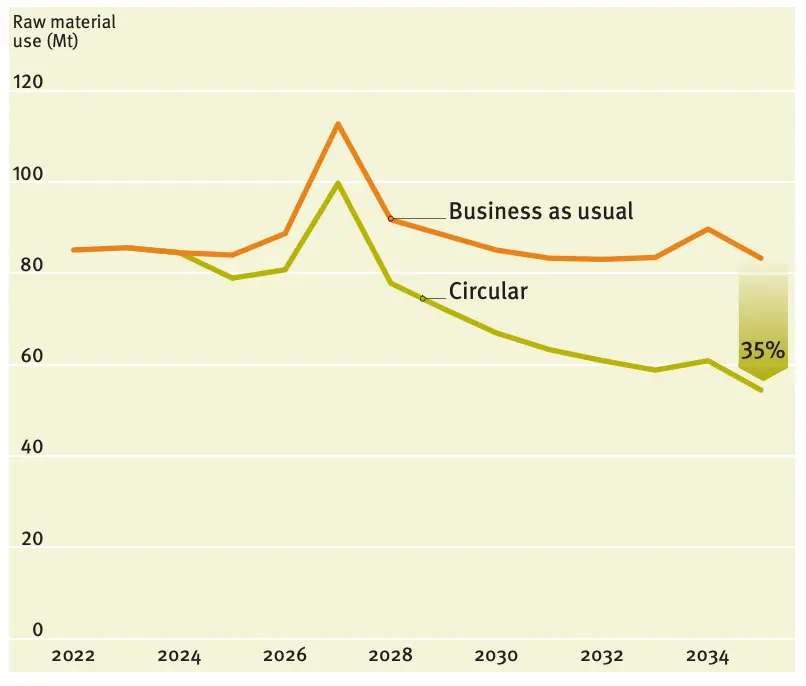
Illustration on how raw material use in construction could be cut by a third by 2035 by the Green Alliance
Enhancing design has the most influence.
Interventions at every stage of the lifecycle are incorporated into a circular construction industry to enhance and minimize resource usage. These interventions fall into one of five categories in our circular scenario: design, demand reduction, reuse, modern construction and material substitution techniques, and recycling. Research indicates that the greatest impact is achieved by interventions that optimize material utilization during the design phase, such as lowering the over specification of structural steel and concrete. This is particularly so in the case of concrete, which made up over three quarters of the raw material used in construction in 2018. Similarly, other cement based products, like mortar and plaster, stone and clay products, like bricks and tiles, are often difficult to remove from a building for reuse. So initial design decisions that reduce demand for them in the first place will have a big impact.
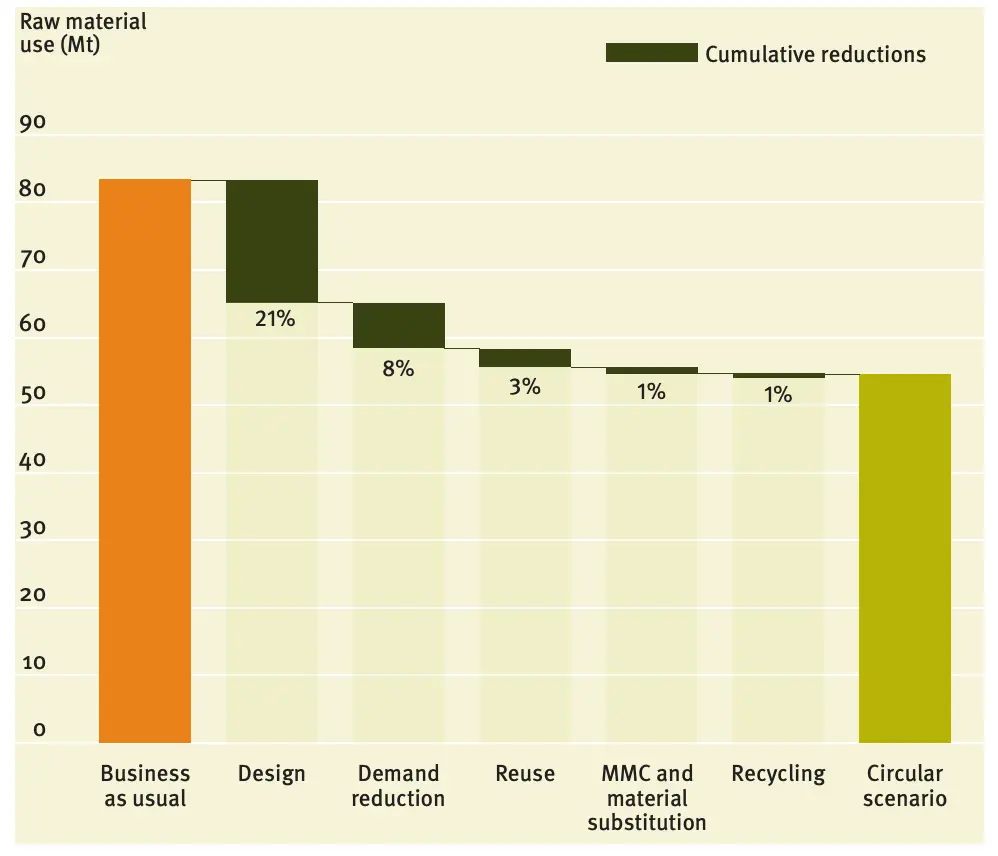
Graph by the the Green Alliance Representing the best way to reduce raw materials
Changes to design should be paired with other approaches to optimize material use. For some materials, reuse and recycling are more critical. Reuse generally has a greater impact than recycling, especially for clay-based products like bricks, as well as for steel sections and sheets, and timber. Recycling is particularly significant for aluminum, plastic, glass, and steel, leading to major reductions in the demand for virgin material. After design improvements and reuse, the recycling rates for aluminum, glass, plastic, and steel can reach up to 95%. However, since these materials are used in smaller volumes, their overall impact on total material use in the sector is relatively low.
Material substitution could slightly increase overall material use by 1% if timber is used instead of concrete, steel, and bricks. However, sustainably sourced timber is a better choice as it is renewable and acts as a long-term carbon store. Countries aiming to increase timber use in construction, such as the Netherlands, exclude timber and other bio-based materials from their raw material use calculations, considering them renewable unlike finite mineral and metal resources.
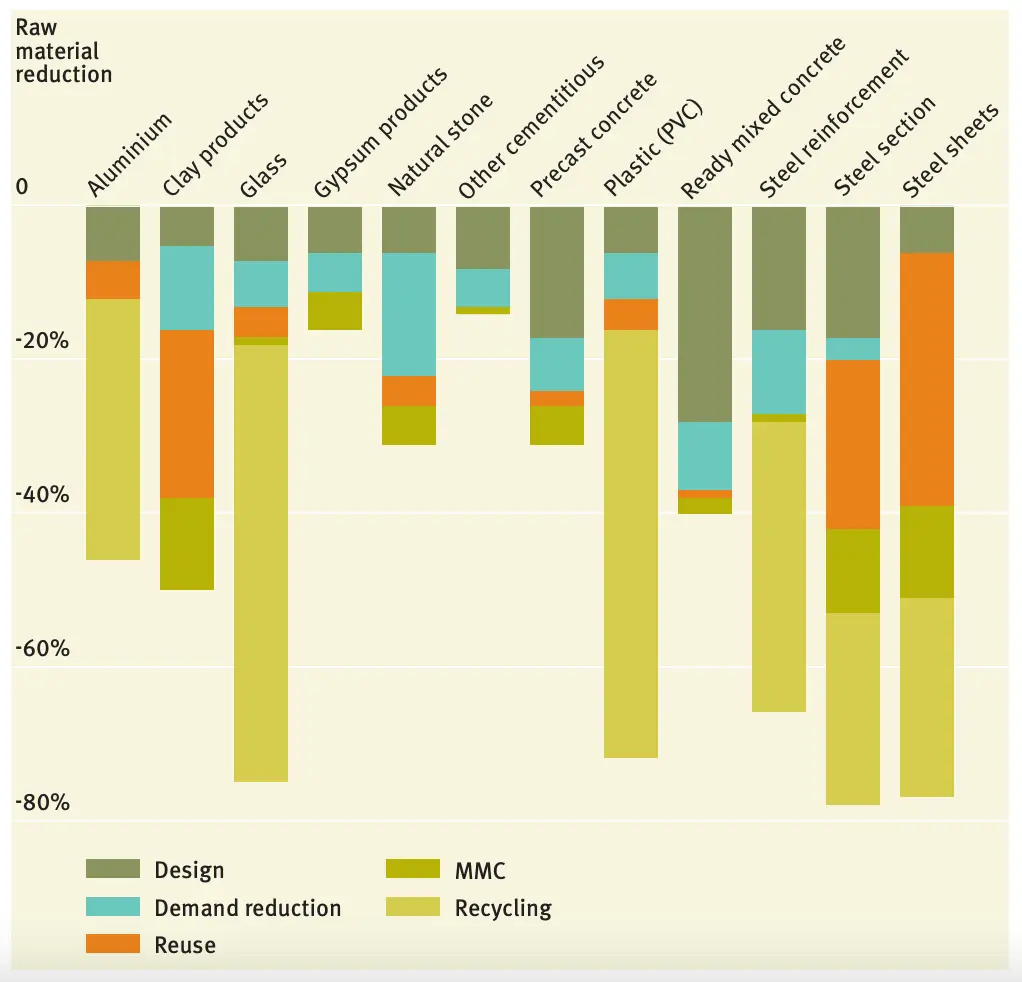
Graph by the Green Alliance
The most effective circular measures vary depending on the material, as this graph illustrates. Reuse can be crucial for steel and clay goods (bricks), recycling is key for plastics, glass, and aluminum, and design modifications are the main strategy for lowering the total quantity of concrete used.
Reducing the raw materials needed for construction leads to significant carbon savings. A 35% reduction in raw materials in a circular scenario would cut annual upfront carbon emissions from construction by 10MtCO2e. This carbon saving is calculated before considering reductions from lower carbon production methods and the shift to low carbon transport and energy systems. Foundation industries, such as cement, metals, glass, and ceramics, are challenging to transition and may still emit some carbon into the 2040s. For instance, over 60% of upfront carbon emissions from construction in 2018 were caused by concrete and other cementitious materials. The sector plans to use carbon capture and storage (CCS) to meet net zero targets, but this process is costly and energy-intensive. Material reduction through circular measures can help achieve net zero targets faster, at a lower cost, and with less environmental impact.
Moreover, while metals like steel and aluminium account for only 3% of material use by weight, they contribute 26% of the construction industry’s upfront carbon emissions. Reducing the amount of new metal needed through better design and higher reuse levels would significantly impact reducing total carbon emissions.
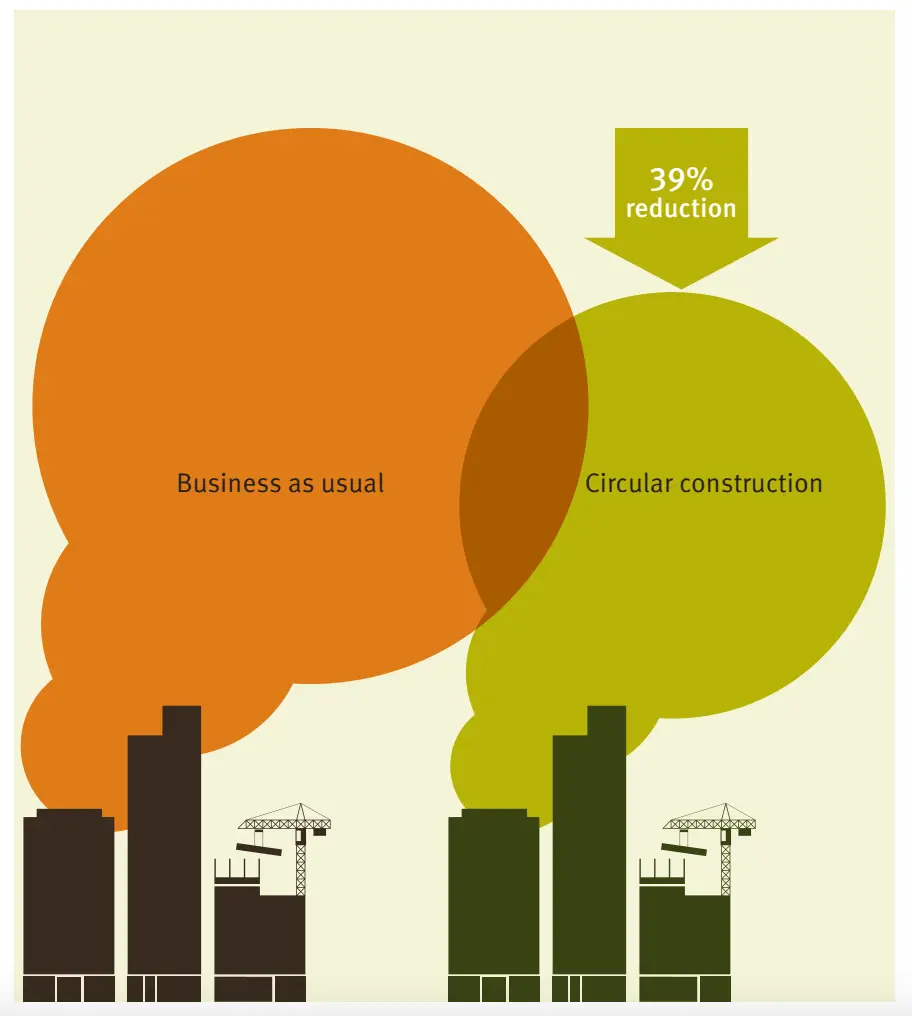
Illustration by the Green Alliance showcasing nearly 40 per cent of upfront carbon emissions from construction can be cut through resource efficiency
More advantages of reduced material consumption for the environment
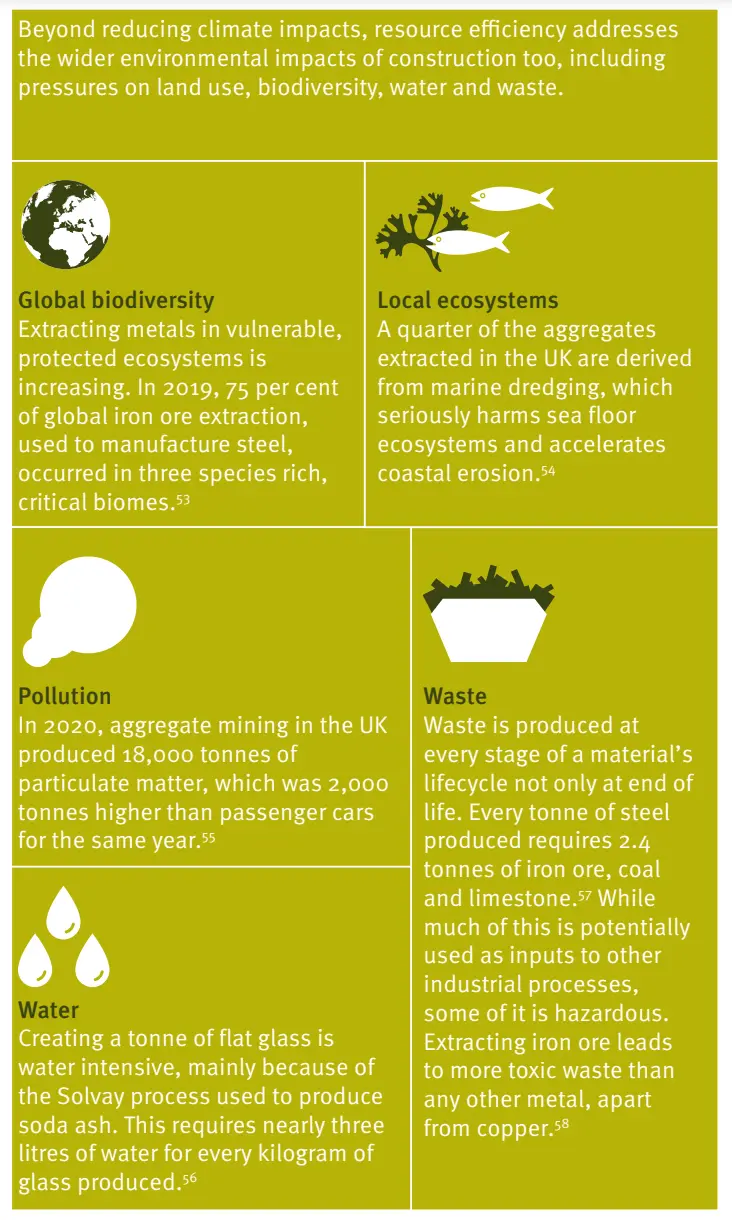
Table by by the Green Alliance
Material impacts
The lack of data makes it challenging to quantify the impacts of reducing raw material use beyond carbon savings. The effects also depend on the processes used and the location of extraction. For example, the impact on water resources of a mine in a desert will differ significantly from one in a rainforest. Similarly, biodiversity impacts and the potential for nature restoration vary between agricultural land and complex environments like peat bogs or tropical forests.
Our assessment of commonly used UK construction materials shows the severity of current impacts and the potential for improvement. We used comparable metrics from independent sources for locations supplying the UK when available. In some cases, we relied on data from trade associations, global averages, and non-comparable metrics. The grey areas in our best practice potential table indicate where we couldn’t assess due to insufficient information. A government priority should be to close these information gaps to ensure a better understanding of material impacts.
Available data clearly shows that no material can be considered ‘green’ on all counts, even with best practices. Even timber, which has the potential to perform best, faces questions about scalability not captured in our assessment. This underscores the importance of not only careful sourcing and processing but also reducing overall material use.
Assessments
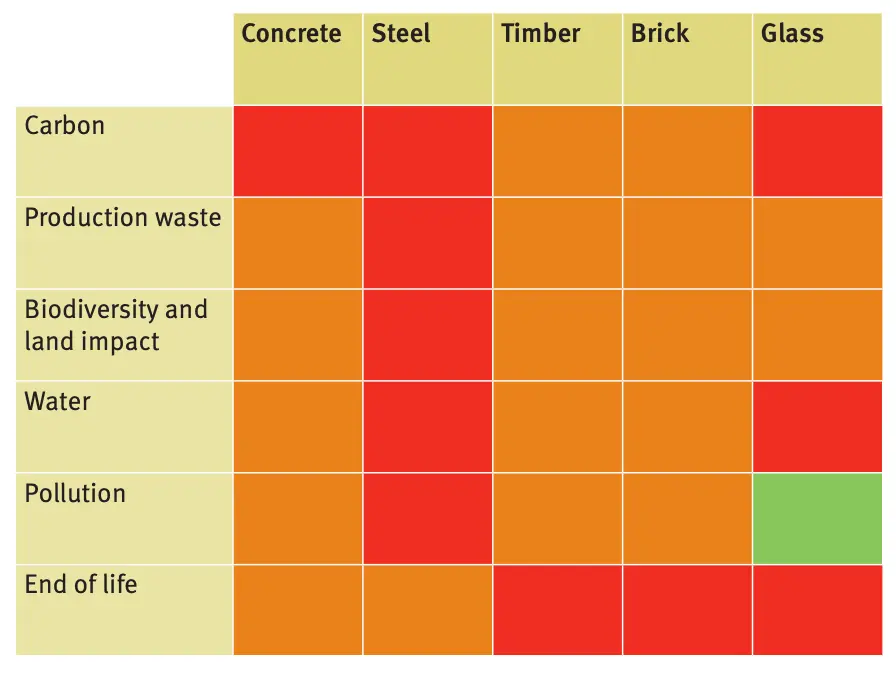
Impacts of typical material use in construction by the Green Alliance
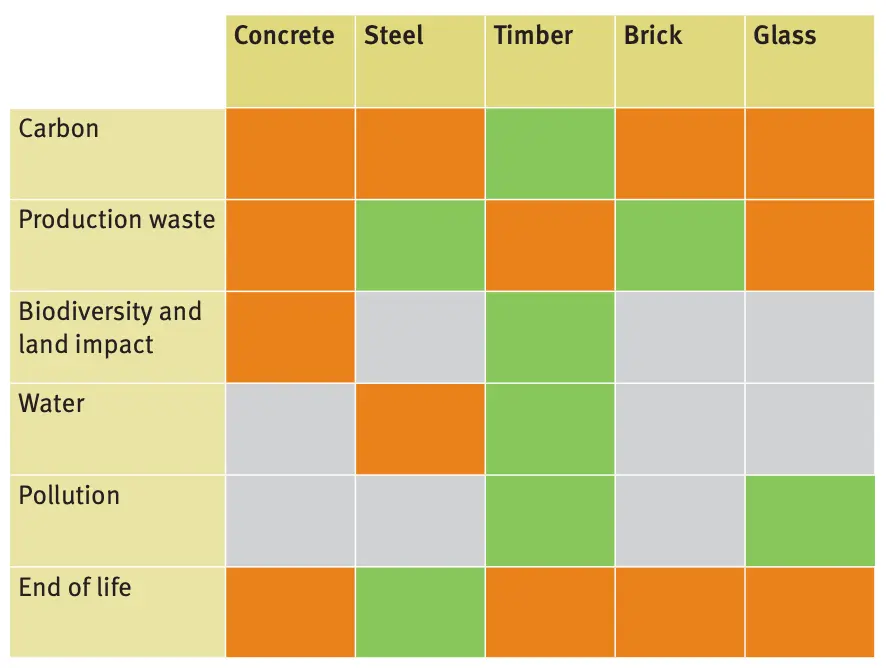
Best practice potential by the Green Alliance
Could Timber be the answer?
Wood is praised as a sustainable construction material for its carbon storage capabilities, making it a highly sustainable use of biomass according to the Climate Change Committee. Using cross-laminated timber instead of concrete can reduce embodied emissions by 60% and increase carbon storage by 400%. Timber is also renewable, unlike other structural materials.
However, if trees are not planted, maintained, or harvested properly, forestry has a negative impact on the ecosystem. Approximately 90% of the world’s certified sustainably managed forests are located in North America and Europe, accounting for just 8% of all certified forests. Only 42% of the UK’s primary and secondary imports of tropical timber are independently certified by the Forest Stewardship Council (FSC) and the Programme for the Endorsement of Forest Certification (PEFC). Products, like plywood, are mostly supplied from China and Brazil. According to some experts, there is a high prevalence of fraud and mislabelling in the “sustainable timber” industry, and standards are inadequate.
The UK uses less timber in construction than many EU countries but sources most from well-managed EU forests. Even with increased use, this trend is expected to continue. Some experts warn that global demand from 2020 to 2050 will exceed sustainable supply by 3,900Mt.
Expansion impacts vary by region: Europe could benefit, while Latin America might see biodiversity decline. Experts agree on the careful expansion of timber use for structural frames and increased use of lower-grade timber in engineered products.
More on timber’s benefits and how it can help you build more sustainably in this interesting article.
Changes that need to take place
The UK construction sector has significant untapped potential to reduce its environmental impact. Efficient use of building materials can enhance business resilience to supply chain pressures and save money through circular economy practices. To achieve these benefits and help the sector contribute to the net zero carbon goal, the government should set a bold, sector-specific resource reduction target and outline how to achieve it. Analysis shows it is possible to reduce raw material use by 35% by 2035 using current technology and best practices. Setting a resource reduction target will incentivize reuse and retrofitting, curbing material over specification and spurring further improvements and technological advancements.
This approach mirrors the UK’s successful strategy for reducing greenhouse gases, driven by the 2008 Climate Change Act and the net zero carbon goal. Setting targets created a cycle of progress, with new techniques and technologies making these goals more achievable. Independent advice from the Climate Change Committee, including sector-specific recommendations and five-year carbon budgets, could be replicated to reduce resource use.
Experts agree that no new technologies are needed to start; instead, the focus should be on following best practices and adopting new technologies as they emerge. Government policy is crucial in steering the construction industry toward greater resource efficiency and reducing environmental impacts. Three priority interventions are recommended for the government to help the industry meet an ambitious reduction target, acting urgently given the sector’s significant material use and environmental impact.
Financial Incentives and Support
Remove VAT on Retrofit: New builds are zero-rated for VAT, while renovations are taxed at 20%, favoring demolition over restoration. Making the VAT holiday on energy-saving products permanent and expanding it to other retrofitting activities could stimulate economic growth and job creation.
Target Innovation: Smaller companies struggle to bring new solutions to market due to funding challenges. Dedicated funding and greener public procurement processes would support circular economy innovators. The successful Innovation Energy Efficiency Accelerator model could be replicated.
Reintroduce a National Industrial Symbiosis Programme: Reviving the program could improve the reuse of construction materials, creating supply chains for secondary materials and reducing resource-intensive ‘just in time’ business models.
More Circular Design and Retrofitting
Assess Circularity at the Start: Require developments to submit circularity statements and carbon reduction plans. Design codes should include upper limits on material use to prevent over specification.
Require Pre-demolition Assessments: Assess the necessity of demolition in terms of carbon emissions and material use, and explore reuse potential. This should include urban density considerations to promote low-carbon lifestyles. Permitted Development Rights (PDRs) should be reviewed to ensure high-quality residential conversions.
Improved Data
Better Measurement
Prioritizing metrics is a good idea before using them to establish goals. Measuring the impact caused by the implementation of circularity is complex, inconsistent, and rare, as stated by the UK Green Building Council (UKGBC). The Low Energy Transformation Initiative (LETI), which is a network of more than 1,000 experts in the built environment, the Institute for Structural Engineers, and the UKGBC are collaborating to determine which criteria should be given priority in order to promote much higher levels of circularity in the building industry. There ought to be a collection of measurements, including:
Material intensity: the total mass of material used per square metre of building.
Reused material content: the proportion of structural materials used in a building that have undergone minimal reprocessing.
Recycled material content: the proportion of material that has been reprocessed into the building structure; high and low quality recycling should be differentiated to encourage the use of materials at their highest possible value.
Reusable materials: the products and components available for structural reuse in future, to encourage more careful disassembly.
These initiatives should be coordinated and supported by the government. When the most effective metrics have been determined, the building sector ought to be required to employ them. Before targets are created, reporting should be integrated over a few years, depending on the updated, thorough body of evidence.
Introduce British Material Passports
- Material passports are essential for facilitating circularity, particularly for long-lasting building structures. These passports provide critical information about the materials, components, and products used in construction, aiding in maintenance, resource extension, and high-value reuse.
- Key information should include expected lifetimes, maintenance requirements, and chemical properties.
- The government should build on best practices from the EU’s Buildings as Materials Banks (BAMB) project and similar initiatives in the Netherlands.
- Information gathered should be stored centrally and be easily accessible to all relevant stakeholders.
Summary
The UK construction sector has significant untapped potential to reduce its environmental impact and enhance economic resilience through the adoption of circular economy practices. By reducing raw material use by 35% by 2035 using current technologies and best practices, the sector can save costs, lower carbon emissions, and improve supply chain efficiency. Key recommendations include setting bold resource reduction targets, removing VAT on retrofits, supporting innovation, and improving data metrics. The government should also introduce British material passports to facilitate the reuse and recycling of building materials, following best practices from successful international initiatives.
Sources
Net zero ready new build housing benefits and barriers to delivery — Cambridge center for housing planning research
Net zero whole life carbon roadmap — UKGBC
from principles to practices: realising the value of circular economy in real estate — Arup and Ellen MacArthur Foundation
Circular construction: building for a greener UK economy — Green Alliance UK
Related articles

Climate-Resilient Materials for the Built Environment: A Data-Centred Prime
As climate volatility intensifies, resilience metrics are fast becoming as critical as carbon data in material selection. This article outlines why adaptation is now a design imperative, how materials can be evaluated through a systems lens, and what KPIs project teams should demand. From self-healing concrete to fire-rated façades, we present a structured taxonomy of resilient materials, explain how to embed this intelligence into digital design workflows, and propose next steps for specification, benchmarking, and procurement.
Read more
The Most Interesting Low Carbon Products in Office Design
In this article and collection, we highlight 11 outstanding products that contribute to a lower carbon footprint in office design.
Read more
Top Low Carbon Building Boards: Performance, Benefits, and Use Cases
The building boards highlighted in this article and collection showcase low-carbon innovation in modern construction.
Read more